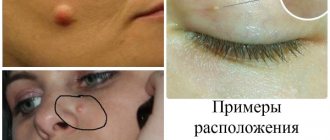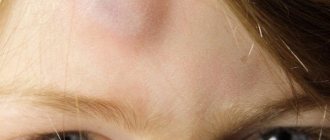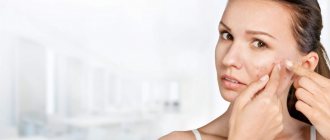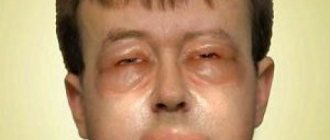One of the patients, a French teacher, told the following story: “At the beginning of her career, she was asked to help a little with translation for a Swiss journalist who flew to St. Petersburg on business. During their first meeting, the Swiss immediately asked if she knew the technique of simultaneous translation. The girl answered in the negative and decided that the interview was over, but the employer surprised her by saying that it no longer mattered, and in an hour they should be in the mayor’s reception room. At the moment of this strong experience, she accidentally saw her reflection in the mirror. The picture was frightening: the whole face and neck were covered with bright red spots, which were miraculously set off by the purple dress. For the rest of the time, she was no longer worried about how she would cope with simultaneous translation, but whether she would have time to turn pale.”
Fortunately, the story ended positively in every sense, but how many unpleasant moments can untimely vessels cause?
Skin health is largely a matter of vascular health. The physiological supply of nutrients to the skin and the normal course of thermoregulation processes are possible only with adequate functioning of the microvasculature. Normally, microcirculation is provided by the arteriolar choroid plexus (subpapillary - located on the border of the papillary and reticular layers of the dermis and subdermal - located on the border of the dermis and subcutaneous fatty tissue) and the superficial and deep venular choroid plexus.
Thermoregulation is provided by deeper vessels: mainly subcutaneous arterial and larger venous plexuses.
A number of exogenous and endogenous factors can have a damaging effect on the vascular wall:
- Hormonal and neurogenic factors
- Sharp fluctuations in high and low temperatures
- Mechanical skin damage
- Digestive diseases
- Ultraviolet irradiation
Let us consider the mechanisms of action of the most significant factors in a little more detail.
Hormonal and neurogenic factors
Estrogens influence the sympathetic nervous system by acting on 2-adrenergic receptors, which leads to vasospastic reactions. Starting from a certain age (about fifty years), the production of estrogens and progesterones decreases in the female body. This condition is very often accompanied by a feeling of heat, temporary, sometimes long-lasting facial hyperemia.
In general, vasospastic diseases and reactions (Raynaud's phenomenon) are more common in women and are more common during the reproductive period. During pregnancy, a decrease in the vasospastic readiness of facial skin vessels is often observed. Microcirculation in the facial skin varies throughout the menstrual cycle.
How to disguise
When redness cannot be removed, it can be hidden. Here you need to remember that pink and peach tones only aggravate the situation. Focus on the shade of the skin on your neck - it is according to this that you need to select a foundation. Are you worried about local redness? You can get by with a yellowish and slightly earthy-toned corrector (but without pink pigment in the composition!). If you cannot imagine life without powder, apply it to the skin with a brush or puff with light patting rather than stretching movements.
Sharp fluctuations in high and low temperatures
The effect of cold on the condition of blood vessels should not be underestimated - the first reaction to a decrease in temperature is a sharp vasospasm in order to reduce heat transfer. Subtle mechanisms of autonomic regulation are activated, followed by compensatory vasodilation.
Many clinical symptoms of prerosacea and rosacea develop through this mechanism.
The autonomic nervous system has both direct and indirect effects on the microvasculature. Normally, the vasoconstrictor effect is exerted by norepinephrine, which acts on alpha-1 adrenergic receptors; vasodilator - adrenaline acting on beta-2 adrenergic receptors of smooth muscle cells of arterioles.
The production of acetylcholine is accompanied by dilation of the vessel and an increase in the speed of blood flow in it (due to stimulation of NO production through M receptors). This vascular response is called endothelium-dependent dilation. A mechanism of endothelium-dependent vasoconstriction associated with the synthesis of endothelin-1 and 20-HETE in the endothelium is also identified.
Autonomic dysfunctions contribute to disruption of homeostasis and adaptation of the body to various environmental influences and lead to disruption of the skin structure, increased permeability of the vascular wall, decreased barrier functions of the epidermis and create conditions for the development of inflammation in the skin.
Many clinical symptoms of prerosacea and rosacea develop through this mechanism.
Diagnosis of hyperemia
Red facial skin can be both a protective reaction to irritants and a signal of disturbances in the human body. Timely diagnosis and treatment help delay the development of serious pathologies. Studying the problem begins with collecting complaints and medical history. Thus, episodes of skin color changes should be carefully analyzed.
If the redness on the face is of a short-term local nature, has a clear connection with any cause, goes away on its own after it is eliminated and is not accompanied by other symptoms, then a person can cope with the change in skin color without outside help.
In cases of systematic red spots on the face, the causes of which are unclear, the help of a specialist is necessary. The reason to urgently contact him is the simultaneous combination of redness on the face and peeling, itching, burning, microcracks, as well as general weakness, fatigue and disruption of the internal organs.
In such cases, laboratory tests of blood and urine, available instrumental studies of the cardiovascular system (measurement of blood pressure and pulse, ECG and assessment of the condition of blood vessels) are performed. Taking into account preliminary data, the doctor may prescribe dermatological and allergological tests, determination of the hormonal profile, and in-depth instrumental procedures (radiography, ultrasound, MRI, CT).
Modern laboratory and instrumental equipment will provide the opportunity for comprehensive general clinical observation, and the joint work of several specialists will make it possible to more accurately determine the nature of facial redness and its causes.
Digestive diseases
Diseases of the gastrointestinal tract can indirectly affect vascular health. Irritation from the mucous membrane of the gastrointestinal tract is transmitted through the branches of the vagus nerve to its nuclei, the excitation passes to the nearby nuclei of the trigeminal nerve and through the branches of the latter enters the central zone of the face, causing vasodilation.
Recent studies confirm that the bacteria Helycobacter pylori persisting in the gastric mucosa contributes to the disruption of neurochemical regulatory mechanisms, which in turn lead to vasodilation.
How to treat
If the reason is not a vegetative reaction, but dilated blood vessels, the problem can and should be dealt with. There are several methods, and among the most popular are laser therapy and photo exposure. The doctor gives preference to one method or another depending on the specific case. Phototherapy can be considered a more gentle option (plus it also fights pigmentation). Lasers, in turn, are less friendly, but are more effective at removing highly visible blood vessels.
You can’t expect complete help in eliminating rosacea from cosmetic products, so it’s better to rely on them to reliably protect the skin and prevent redness. The composition of such cosmetics should include the following components: amino acids, oils with saturated fatty acids, urea, chitosan, hyaluronic acid. Vitamin C and troxerutin, which help strengthen the walls of blood vessels, will also not hurt. One caveat: knowing the ruddy characteristic of your skin, try to use professional cosmetics that are effective and efficient. There is a taboo on cosmetic preparations with aggressive acids, which can aggravate the redness process, “hard” peels and laser dermabrasion.
Ultraviolet irradiation
The sun is life! We know how important vitamin D is for beauty and health, but we must not forget about the harmful effects of ultraviolet rays.
In particular, it was found that 50% of UVA rays penetrate the skin to the papillary and reticular layers. They damage the endothelial cells of blood vessels and the basement membrane of the lymphatic microvessels of the skin, which leads to disruption of blood outflow.
As a result of adverse environmental influences and violations of internal regulatory mechanisms, the number of patients suffering from disorders of skin microcirculation is increasing - seeking help as cosmetic defects develop.
We are faced with the task of increasing the tone of the vascular walls and restoring their structure, eliminating the signs of sensitive skin (erythematous-squamous spots, rosacea, angioneurosis) and the associated discomfort.
As a result of adverse environmental influences and violations of internal regulatory mechanisms, the number of patients suffering from skin microcirculation disorders is increasing.
Especially to solve these problems, ]Pevonia Botanica[/anchor] has developed a line of RS2 products for very sensitive skin with microcirculation disorders.
Main active ingredient : licorice extract
, contains 18-beta-glycerrisic acid.
The medicinal properties of licorice were known long before the discovery of its component composition; modern scientific research has proven that glycyrrhizic acid is a unique natural compound with anti-inflammatory, reparative and vasoconstrictor effects. The composition also includes green tea, incense, B vitamins and microelements - all together this has a prolonged restorative effect on the structure of the vascular wall, strengthening blood vessels, reducing the manifestations of rosacea and congestion.
Allergy to cold
It really exists and occurs during prolonged exposure to the cold. Its main symptoms are redness, itching, peeling. What's happening? The blood vessels react to the effects of low temperatures by constricting, that is, they spasm, protecting the skin from cooling and retaining heat as much as possible, which is why the skin first turns pale in the cold. Then comes the compensation stage: during prolonged exposure to cold, the blood vessels dilate to avoid frostbite and maintain nutrition and blood supply to the skin. At the same time, the capillaries expand, and the skin turns red ─ a bright blush appears (after normalization of the temperature, the skin, of course, calms down). In people with fragile vessels, such processes work less well, and redness may last longer. The measures to combat it are simple: eliminate skin contact with low temperatures, and then restore its protective functions, first of all, LES (lipid-epidermal substance), and then maintain hydrobalance.
But it is always better to prevent than to treat, so use special protective creams a couple of hours before going outside, avoid eating food and medications that increase the allergic background, and also protect exposed areas of the body from adverse weather factors (strong cold wind, scorching sun). In some cases, it is advisable to resort to taking antihistamines, but it is better to consult a doctor about this.
Redness of the eyes due to a hangover
Often facial swelling after alcohol is not the only symptom of a hangover. Bags under the eyes and redness are also consequences of alcohol abuse. Eye drops that constrict blood vessels will help here. However, we must remember that their action provokes an increase in intraocular pressure, and the feeling of discomfort is not removed. Recommended eye drops:
- Visine;
- ophthal
- tetrizoline;
- vial;
- vitoptik and others.
It should be borne in mind that deterioration in appearance is not the worst consequence of excessive alcohol consumption. Very often, alcohol provokes or aggravates a serious illness. It is not always possible to recognize alarming symptoms in time, so it is important to be attentive to all the signals that the body sends.
What causes involuntary shaking (tremor)?
Chronic alcoholism occurs with certain symptoms, including tremors of the head, hands, and tongue. This is an involuntary small trembling that tends to intensify in the morning and on an empty stomach. In some cases, after eating or drinking, the tremor disappears, so alcoholics cannot do without a hangover. At the same time, a person without alcohol dependence in a state of hangover experiences an aversion to alcohol (to the smell and sight).
Do not confuse small and large tremor. The latter affects the entire body and most often occurs after a single excessive use of alcohol. It does not indicate the development of addiction, but indicates acute poisoning. This requires urgent removal of harmful products from the body through detoxification. It is recommended to consult a doctor for advice on effective ways to eliminate toxins.
Correct approaches to treating rosacea
Rosacea is considered a chronic disease, the manifestations of which disappear and appear again. By following medical recommendations, you can return your skin to its original appearance and natural, light color.
Home care rules
Do not apply to irritated, inflamed skin with redness:
- Scrubs and rolls with fruit acids that injure the surface. They will not clear the skin, and can cause an exacerbation of rosacea.
- Alcohol-containing lotions that irritate the inflamed surface.
- Fatty creams that disrupt the natural pH balance and close pores.
The epidermis needs to be moisturized. Wash with water at room temperature. When walking in the sun, use SPF cream with sun filter 30 or 50. Try not to go outside in frost or strong wind.
Important! Following these care rules will not get rid of rosacea, but you can minimize irritation and soothe inflamed skin.
Local treatment
Local treatment, which includes superficial procedures, helps relieve signs of rosacea. The therapeutic effect is achieved when using:
- Azelaic acid, which is used for various forms of rosacea. It affects acne, reduces the amount of fatty acids in the lipids of the dermis, and restores metabolic processes in the follicles of the sebaceous glands.
- Metranidazole, which helps remove papules and pustules. Papules are nodular formations that appear as redness and rash. Pustules are blisters with purulent contents that appear with prolonged rosacea.
- Antibiotics prepared in the form of lotions or mash. They have a wide spectrum of action. They are applied locally to the acne area, which helps remove infectious pustules.
- Antiparasitic drugs, if larvae of mites of the genus are found during scraping in the pustules
A similar treatment regimen is used if redness needs to be removed at an early stage of rosacea. When the disease is not advanced, medicinal ointments and creams can clear up skin rashes.
Note: It is necessary to switch to dietary nutrition, eliminating spicy, hot, spicy, salty, and sour foods from the diet. You should give up alcohol and tobacco.
Drug treatment
In severe cases of the disease, rosacea must be removed in the clinic. In this case, dermatologists usually prescribe systemic drugs. In addition to anti-inflammatory therapy, they restore the protective function of the skin and at the same time saturate them with moisture.
The doctor considers the main tasks to be:
- remove the exacerbation stage;
- remove symptoms of the disease;
- increase remission time.
Medicines used:
- antibacterial nature, if microorganisms are found in the scraping;
- antihistamines to relieve possible allergies;
- antibiotics to clear up severe rosacea;
- agents that relieve inflammation;
- glucocorticosteroids.
The treatment is based on injection therapy to restore the skin's hydrobalance, as well as peeling to remove papules, pastulas, and smooth the surface layer of the epdermis. Ointments are used that are combined with other forms of treatment.
Preparations containing hyaluronic acid, amino acids, nucleic acids, vitamins and minerals are administered as injections. Vitamin-mineral complexes strengthen vascular walls.
Special, therapeutic peels of superficial and medium action help to remove the signs of rosacea. To get rid of redness quickly, superficial peeling in combination with injections is suitable. At the same time, the person does not “fall out” of the social lifestyle, since the rehabilitation period is short. During treatment
- metabolic processes are restored in the dermis;
- neurogenic inflammation is relieved;
- “on the face” serbo-regulating and moisturizing effect.
Important! You should not use peels based on fruit acids or salicylic acid, which do not remove rosacea and lead to worsening inflammation.
How to get rid of redness from rosacea
The beautiful name “rosacea” conceals a rather unpleasant disease, the manifestation of which is expressed “on the face”. It is on the face that redness of an incomprehensible nature occurs. Sometimes they appear after going to the bathhouse, walking on a sunny day, after jogging or drinking alcohol. The reasons are different, but there is one sign – redness. Sometimes it gradually goes away, then appears again. And over time it becomes a “constant companion.” What causes the disease and how to remove rosacea on the face: this is the question that worries us today.
Exaggerated blushing
A person susceptible to blushing experiences only two problems: the appearance of a ruddy complexion and the reaction of others to this. As numerous studies say, the second problem is the most serious, because the scarlet color confuses a person, and he tries to hide it or even get away from his interlocutors. This entails problems with society, because the situation calls into question communication with peers. In this case, social phobia develops.
Such behavior is wrong, since in any case the attitude of others towards the issue raised is unknown; maybe they don’t care or they like it. A good solution to this problem would be to ask your social circle how they feel about blushing when talking. The answers will differ from those expected. Indeed, in ninety-nine percent of cases, blushing only decorates the appearance, making it more prettier.
Facial skin diseases, main types
Human skin is capable of responding to any factors: both external (sun, wind, moisture) and internal (processes in the body).
The result of such reactions can be a variety of diseases that cause not only moral, but also physical discomfort. Therefore, at the first suspicion, and even more so symptoms of skin diseases, you should contact a specialist in order to avoid serious health problems and make your life comfortable. Being a kind of litmus test, our skin can react to anything: to changes in hormonal levels - acne, to long-term use of medications - rosacea, to sunbathing - rosacea, and so on.
Modern medicine identifies more than 600 skin problems, the vast majority of which are only the result of some factors, and only a small part of them are directly diseases of the epidermis.
The main diseases of the facial skin are:
- Anke - pimples and blackheads, the appearance of which is caused by disturbances in the functioning of the sebaceous glands;
- Rosacea is a small red or pink rash;
- Cuperosis - spider veins;
- Papillomas are neoplasms on the skin caused by a virus;
- Impetigo is an infectious purulent disease caused by streptococci and staphylococci (expressed in red tuberous rashes and spots);
- Keratosis - small spots covered with rough scales;
- Vitiligo - pink or milky-white spots with a round shape;
- Chloasma is increased skin pigmentation with clear boundaries;
- Seborrheic dermatitis is peeling of the skin in the nose and eyes, characterized by pain and itching.
Physiotherapy
Physiotherapeutic procedures are carried out in parallel with therapeutic effects.
Laser exposure
Laser pulses tone blood vessels and restore blood circulation. Already after the first procedure, the effect is noticeable - reduced redness and a healthier complexion.
The method works as follows: the laser beam acts on all manifestations of rosacea without damaging deeper, healthy tissues.
Laser exposure is carried out after drug therapy, when correction of spider veins or other vascular problems is needed. This physiotherapy procedure can remove skin defects during remission. It is repeated once every 2 weeks with a total number of sessions from 3 to 7.
Note: The laser is not used at the acute stage, when inflammation is severe and dry skin is noticeable. Exposure to a laser beam can make the situation worse.
After completing the full therapeutic course, the patient’s blood vessels are strengthened, swelling and redness are relieved, the number of skin rashes is reduced or eliminated, and itching goes away. This leads to improved quality of life and socialization.
Using high intensity flashes of light
IPL, or high-intensity flashes of light, act locally to destroy oxyhemoglobin in the capillaries. This procedure
- eliminates skin redness;
- visually reduces the severity of the inflammatory process;
- destroys microorganisms on the surface of the epidermis.
Cryotherapy
Cryomassage of the face is cooling of the skin and tissues. The procedure reduces the discomfort of rosacea due to spasm and narrowing of blood vessels. After the procedure, microcirculation and blood vessel filling are enhanced. An increase in blood flow leads to further redness, so the procedure for rosacea is not always prescribed and is considered useful and necessary.
Prevention
Since redness of the skin around the eyes is most often the result of irritation of the visual organs , this should be avoided.
It is necessary to ensure that in the room in which a person stays during the day is not too dry (this problem usually occurs in offices or apartments with working air conditioners).
If there is a need to spend several hours in a row at the computer, you need to take a short break once an hour, which is advisable to use for eye gymnastics.
Remember! If possible, your diet should include foods containing B vitamins (beans, grains, fruits, vegetables, dairy products).
This element restores eye tissue and generally has a positive effect on the functioning of the visual organs.
You need to sleep at least 6-7 hours a day . During this time, the eyes have time to rest from the fatigue accumulated during the day, and the tear membrane is restored.
Causes of redness on the skin
The main causes of erythema on the skin are: Redness of the skin
- irritation: mechanical, high and low temperatures, chemicals;
- allergic reactions (urticaria);
- trauma (redness around the scratch);
- insect and other animal bites;
- autoimmune diseases, for example, eczema, psoriasis;
- infections: viral, bacterial, fungal;
- venereal diseases;
- dermatitis of various origins;
- In young children, a common cause of redness is diaper rash.
Typically, redness is accompanied by swelling, pain (more typical for infections), itching (more typical for allergic conditions).
As you can see from the list above, redness is a symptom of many skin conditions. It is often combined with other skin elements: blisters, ulcers, pustules, nodules, etc. The combination of signs makes it possible to suggest one or another diagnosis.










